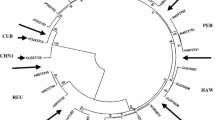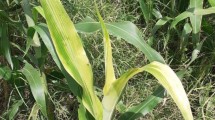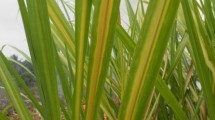Abstract
Yellow leaf (YL) caused by Sugarcane yellow leaf virus (SCYLV) was first reported as a sugarcane disease in the 1990s, when it had already spread over many parts of the world. The time of introduction into the plantations is unknown. A worldwide screening identified only a few places isolated from cultivar exchange for more than 20 years which appeared SCYLV-free. Control tests with infected cultivars propagated for 12–16 generations by cuttings remained SCYLV-infected, proving that SCYLV is not eliminated by vegetative propagation. De novo infection by SCYLV-vectors in Hawaii occurred only over short distances. To reveal the period when SCYLV was introduced to Hawaii, volunteer sugarcane plants from closed Hawaiian plantations and from previous sites of the Hawaiian Sugarcane Planters´ Association breeding station were tested. The results suggest that SCYLV appeared in the breeding station between 1960 and 1970, whereas the plantations became infested after 1980. Imports in the 1960s obviously introduced the virus to the Hawaiian breeding station from where it spread to susceptible cultivars. Eighty percent of the cultivars, developed between 1973 and 1995, acquired the virus at the breeding station, in some cases within 4 years, indicating the rapid spread of SCYLV in the breeding station. The strain of SCYLV found in a Réunion cultivar in Hawaii, and the differing SCYLV-infection of CP-cultivars which were exported more than 20 years ago, suggested that also Réunion and Florida may still have been SCYLV-free in the 1970s. The study showed that retrospective epidemiology can be conducted on a disease which was unnoticed for more than 20 years.







Similar content being viewed by others
References
Abu Ahmad, Y., Royer, M., Daugrois, J.-H., Costet, L., Lett, J.-M., Victoria, J. I., et al. (2006). Geographical distribution of four Sugarcane yellow leaf virus genotypes. Plant Disease, 90, 1156–1160.
Alegría, O. M., Chatenet, M., Girard, J.-C., Saldarriaga, S. A., Nuget, A., & Rott, P. (2000). First report of Sugarcane yellow leaf virus in Peru. Plant Disease, 84, 1342.
Arocha, Y., Gonzalez, L., Peralta, E. L., & Jones, P. (1999). First report of virus and phytoplasma pathogens associated with Yellow Leaf Syndrome of sugarcane in Cuba. Plant Disease, 83, 1177.
Avila, R., Arrieta, M. C., Villalobos, W., Moireira, L., Chavarria, E., Lockhart, B. E. L., et al. (2001). First report of Sugarcane yellow leaf virus (ScYLV) in Costa Rica. Plant Disease, 85, 919.
Bailey, R. A., Bechet, G. R., & Cronje, C. P. R. (1996). Notes on the occurrence of yellow leaf syndrome of sugarcane in southern Africa. South African Sugar Technology Association Proceedings, 70, 3–6.
Comstock, J. C., Pena, M., Vega, J., Fors, A., & Lockhart, B. E. L. (2002). Report of Sugarcane yellow leaf virus in Ecuador, Guatemala, and Nicaragua. Plant Disease, 86, 74.
Comstock, J. C., & Miller, J. D. (2003). Incidence and spread of sugarcane yellow leaf virus in sugarcane clones in the CP-cultivar development program at Canal Point. Journal of the American Society of Sugarcane Technologists, 23, 71–78.
Comstock, J. C., Irvine, J. E., & Miller, J. D. (1994). Yellow leaf syndrome appears on the United States mainland. Sugar Journal, 56, 33–35.
Comstock, J. C., Irey, M. S., Lockhart, B. E. L., & Wang, Z. K. (1998). Incidence of yellow leaf syndrome in CP cultivars based on polymerase chain reaction and serological techniques. Sugar Cane, 4, 21–24.
Fitch, M. M. M., Lehrer, A. T., Komor, E., & Moore, P. H. (2001). Elimination of Sugarcane yellow leaf virus from infected sugarcane plants by meristem tip culture visualized by tissue blot immunoassay. Plant Pathology, 50, 676–680.
Lehrer, A. T., Schenck, S., Yan, S.-L., & Komor, E. (2007). Movement of aphid-transmitted Sugarcane yellow leaf virus (ScYLV) within and between sugarcane plants. Plant Pathology, 56, 711–717.
Lockhart, B. E. L., & Cronjé, C. P. R. (2000). Yellow leaf syndrome. In P. Rott, R. A. Bailey, J. C. Comstock, B. J. Croft, & A. S. Saumtally (Eds.), A guide to sugarcane diseases (pp. 291–295). Montpellier: La Librairie du Cirad.
McAllister, C. D., Hoy, J. W., & Reagan, T. E. (2008). Temporal increase and spatial distribution of Sugarcane yellow leaf and infestations of the aphid vector, Melanaphis sacchari. Plant Disease, 92, 607–615.
Moonan, F., Molina, J., & Mirkov, T. E. (2000). Sugarcane yellow leaf virus: an emerging virus that has evolved by recombination between luteoviral and poleroviral ancestors. Virology, 269, 156–171.
Moonan, F., & Mirkov, T. E. (2002). Analyses of genotypic diversity among North, South, and Central American isolates of Sugarcane yellow leaf virus: evidence for Colombian origins and for intraspecific spatial phylogenetic variation. Journal of Virology, 76, 1339–48.
Moutia, J. F. Y., & Saumtally, S. (1999). Symptomology of yellow leaf syndrome and detection and distribution of sugarcane yellow leaf virus in Mauritius. Proceedings of the International Society of Sugar Cane Technologists, 23, 355–364.
Nadif, A., Chriki, N., & Ouhssine, M. (2002). Detection du virus causant la maladie dite yellow leaf syndrome (YLS) sur la culture de la canne a sucre au Maroc. Bulletin OEPP/EPPO, 32, 521–524.
Rassaby, L., Girard, J.-C., Lemaire, O., Costet, L., Irey, M. S., Kodja, H., et al. (2004). Spread of Sugarcane yellow leaf virus in sugarcane plants and fields on the island of Reunion. Plant Pathology, 53, 117–125.
Ricaud, C. (1968). Yellow wilt of sugarcane in Eastern Africa. Sugarcane Pathologist Newsletter, 1, 45–49.
Robinson-Beers, K., & Evert, R. F. (1991). Ultrastructure of and plasmodesmatal frequency in mature leaves of sugarcane. Planta, 184, 291–306.
Sambrock J., Russell D. W. (2001). Molecular cloning. A laboratory manual. 3rd edition,Cold Spring Harbor Laboratory Press, Cold Spring Harbor, New York, ISBN 0-87969-577-3
Schenck, S. (1990). Yellow leaf syndrome—a new sugarcane disease (pp. 38–39). Annual Report: Hawaiian Sugar Planters Association.
Schenck, S., Hu, J. S., & Lockhart, B. E. L. (1997). Use of a tissue blot immunoassay to determine the distribution of sugarcane yellow leaf virus in Hawaii. Sugar Cane, 4, 5–8.
Schenck, S., & Lehrer, A. T. (2000). Factors affecting the transmission and spread of Sugarcane yellow leaf virus. Plant Disease, 84, 1085–1088.
Smith, G. R., Borg, Z., Lockhart, B. E. L., Braithwaite, K. S., & Gibbs, M. J. (2000). Sugarcane yellow leaf virus: a novel member of the Luteoviridae that probably arose by interspecies recombination. Journal of General Virology, 81, 1865–1869.
Vega, J., Scagliusi, S. M. M., & Ulian, E. C. (1997). Sugarcane yellow leaf disease in Brazil: evidence of association with a luteovirus. Plant Disease, 81, 21–26.
Victoria, J. I., Garces, F., Guzman, M.-L., & Angel, F. (1998). Síndrome de la hoja amarilla en Colombia ScYLV (Sugarcane yellow leaf virus). Carta Trimestral Cenicana (Colombia), 20, 3–7.
Yan, S.-L., Lehrer, A. T., Hajirezaei, M.-R., Springer, A., & Komor, E. (2009). Modulation of carbohydrate metabolism and chloroplast structure in sugarcane leaves which were infected by Sugarcane Yellow Leaf Virus (SCYLV). Physiological and Molecular Plant Pathology, 73, 78–87.
Acknowledgements
The study was supported by a grant of Deutsche Forschungsgemeinschaft. The gift of SCYLV-antibody by Dr. Lockhart (University of Minnesota) is gratefully acknowledged. We are also thankful to Drs. KK Wu, B. Osgood and S. Schenck (HARC, Aiea, USA) for their advice and help. Many researchers helped to obtain samples or tissue prints from sugarcane plants: J. Comstock, USDA, Florida, J. Hoy and L. Grelen, Louisiana, J.-H. Daugrois, CIRAD, Guadeloupe, R. Cu and F. dela Cueva, Philsurin, G.P. Rao, India, M. Casagrande, Brazil, J. Enahari, Morocco, T. van Antwerpen, South Africa, G. Khodjajeva, Uzbekistan, S. Ziad, Syria, B. Fontaniella, Spain.
Author information
Authors and Affiliations
Corresponding author
Rights and permissions
About this article
Cite this article
Komor, E., ElSayed, A. & Lehrer, A.T. Sugarcane yellow leaf virus introduction and spread in Hawaiian sugarcane industry: Retrospective epidemiological study of an unnoticed, mostly asymptomatic plant disease. Eur J Plant Pathol 127, 207–217 (2010). https://doi.org/10.1007/s10658-010-9585-1
Accepted:
Published:
Issue Date:
DOI: https://doi.org/10.1007/s10658-010-9585-1




